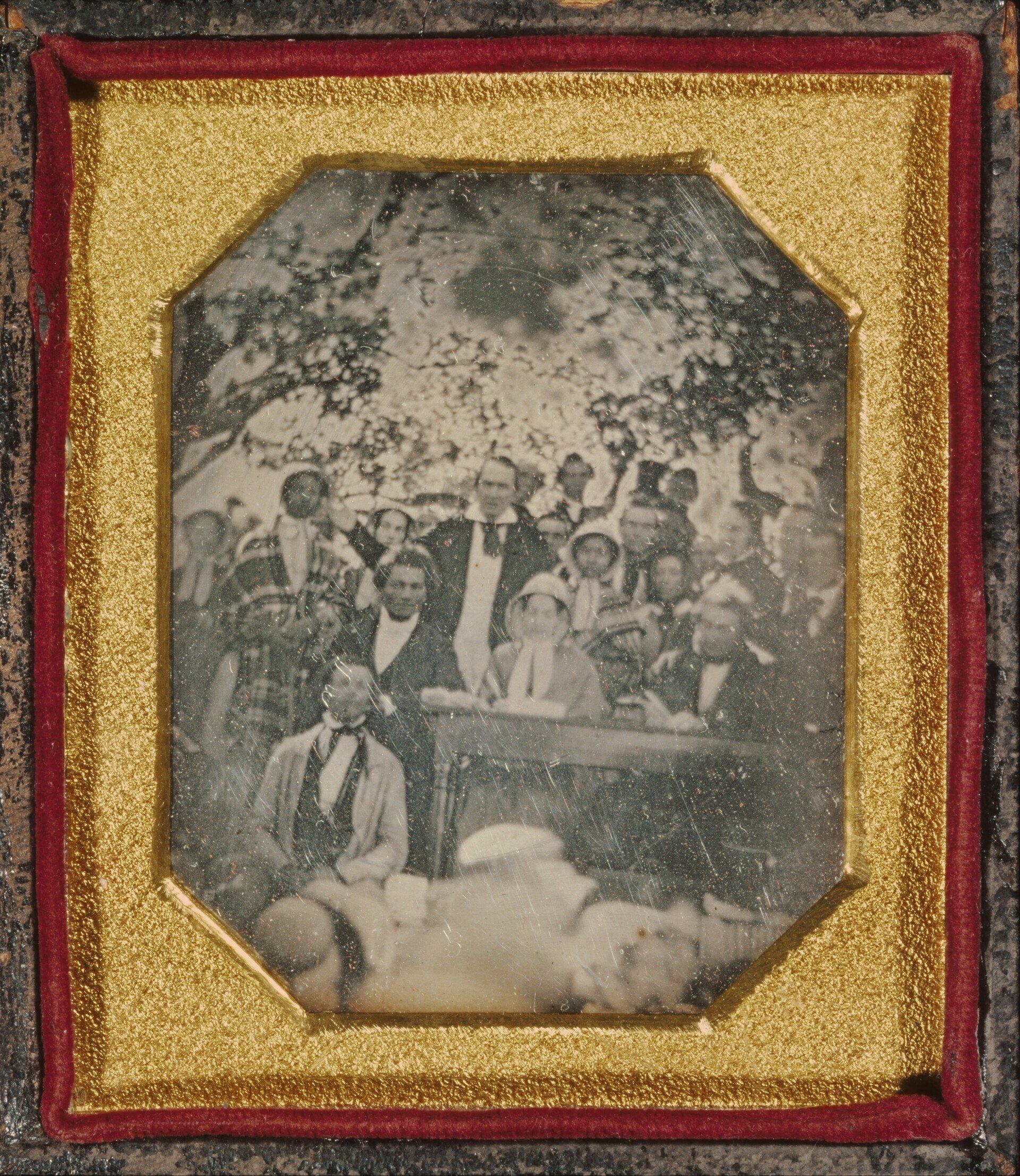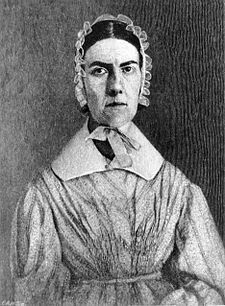Part 2: American Slavery As It Is

This 1850 photo by Ezra Greenleaf Weld is of the Fugitive Slave Convention held in Cazenovia New York in 1850. Theodore Weld is seated in front of Frederick Douglas. (The photo is in the public domain.)
American Slavery As It Is: Testimony of a Thousand Witnesses is by Theodore and Angelina Weld and Sarah Grimke who compiled reports which were graphic and accurately portrayed how absolute power can corrupt people. The stories were hard to read when published and hard to read today. They presented a devastating picture of slavery in America as it was experienced in the 1830s.
Charles Renshaw, who had lived in Quincy in 1838-1839 and served as the minister of the Quincy Congregational Church, knew the Welds, and had his own stories to share for the publication.
Judge Menzies, a Kentucky slaveholder and elder in the Presbyterian Church, told Renshaw that tobacco planters sometimes forced their slaves to eat the loathsome tobacco worms they missed in picking the crop. Renshaw wrote that “the minister and all the church members held slaves. Some were treated kindly, others harshly. There was not a shade of difference between their slaves and those of their infidel neighbors, either in physical, intellectual, or moral state; in some cases, they would suffer in comparison.”
Renshaw had a friend and informant on slave conditions in Missouri who was vouched for by Willard Keyes and Henry Snow, prominent Quincyans. The informant had lived in Missouri for many years, and he shared several anecdotes. He accused John Mackey, a rich slaveholder in Pike County, Mo. of murdering his 14-year-old slave Billy. “He buried him away in the woods; dark words were whispered, and the body was disinterred.” The coroner concluded the boy had died of a fractured skull. “The case was brought into court, but Mackey was rich; and his murdered victim was his slave; and after expending about $500 he walked free.”
This nameless friend of Renshaw also charged a Mrs. Mann of murdering Fanny, a slave woman Mann had hired out from Charles Trabue of Palmyra, Missouri. The mistress was known to use her “six-pound paddle” to torture slaves, and when Trabue heard of Fanny’s death he commenced suit for his property. The coroner brought in a verdict of death by a six-pound paddle.” By relating these stories for the publication, Renshaw made lasting impacts on the anti-slavery cause during his brief stay in Quincy.
Dr. Richard Eells was a deacon in the Congregational Church in Quincy and had a medical practice here. Ezra Fisher was a Baptist minister who lived in Quincy from 1836-1841. They both attested for the honesty of another man who wanted to tell his story but remain anonymous. Their names appear in the section “Testimony Of A Virginian.” Eells and Fisher said of the man: “We have great confidence in his integrity, discretion, and strict Christian principle.” The Virginian then described seeing hundreds of slaves, all chained and fastened together in long lines. He said, “every coffle was a scene of misery and woe, of tears and brokenness of heart.” Dictionaries describes a coffle as a group of prisoners, slaves or animals tied together in a line.
Dr. Eells is known in history for his arrest and court case for aiding a fugitive slave from Missouri escape through Quincy. He was found guilty in the Adams County Circuit Court presided over by Stephen A. Douglas and fined $400. The Eells case was the only Underground Railroad case appealed to the U.S. Supreme Court, which upheld the doctor’s conviction in 1852 even though the doctor had died several years before.
George Westgate, along with Eells, was a member of the Congregational Church. He gave the most narratives of anyone in town. He navigated the old southwestern slave states as a keel boat trader for twelve years. He shared startling impressions of slave culture. He described the crude lodging and clothing he witnessed in lower Tennessee, Mississippi, and Louisiana. The long workdays that began at 4 a.m. and scant diets that slaves survived on. He wrote of agonizing whippings on Widow Calvert’s plantation near Rodney, Miss. “The expression ‘whipped to death’ as applied to slaves, is common at the south.”
Westgate also said that a planter from Orange Five Points plantation near New Orleans had placed a runaway slave on his keelboat to be sent back home. The young slave told him he expected to be whipped almost to death. Pointing to a graveyard, he said: “There lie five who were whipped to death.” He added, “Overseers generally keep some of the women on the plantation. I scarce know an exception to this. Indeed, their intercourse with them is very much promiscuous. They show them not much, if any, favor. Masters frequently follow the example of their overseers in this thing.”
Westgate lived on the same block as several other abolitionists near Fourth and York. He and one other Quincyan helped David Nelson escape Missouri when he fled to Quincy in 1836. Quincy was in a perfect location to help slaves and chased abolitionists escape from Missouri.
Harriet Beecher Stowe was heavily influenced by American Slavery As It Is stories for her book “Uncle Tom’s Cabin.” Her sister Catherine Beecher once had a girls’ school in Quincy, and she was a close personal friend of Sarah Grimke. Their father, Lyman Beecher, was also president of Lane Seminary in Cincinnati when Weld and Renshaw were expelled in 1834 for organizing anti-slavery debates.
Frederick Douglas was still a slave when the book was being compiled. He did not escape slavery until 1838. Douglass frequently referenced American Slavery As It Is in his speeches. He said, “not a single fact or statement recorded therein has ever been called in question by a single slave holder."
The main author and dedicated freedom-lover, Theodore Weld, was described as ‘the most mobbed man’ in America during his fervent speeches. Theodore and Angelina were married in 1838. They moved to a farm in New Jersey where they and her sister Sarah compiled American Slavery As It Is, which they published in 1839.
Heather Bangert is involved with several local history projects. She is a member of Friends of the Log Cabins, has given tours at Woodland Cemetery and John Wood Mansion, and is an archeological field/lab technician.
Sources
Angelina Grimke Weld, and Sarah Grimke, 1822-1844. 2 vols. Gloucester, MA: Peter
Smith, 1965.
Ankrom, Reg. “Elijah Lovejoy and Quincy Abolitionists.” Quincy Herald Whig, June 30, 2013.
Ankrom, Reg. “Rev. Nelson and Abolition Come To Quincy.” Quincy Herald Whig, Dec. 23, 2012.
Bangert, Heather. “Black Abolitionist Network Grew With City.” Quincy Herald Whig, Jan. 11,
2015.
Barnes, Gilbert H., and Dwight L. Dumond, eds. Letters of Theodore Dwight Weld, Angelina
Grimke Weld and Sarah Grimke,1822-1844. 2 vols. New York and London: Appleton-
Century Company, 1934.
Barnes, Gilbert H. The Anti-Slavery Impulse: 1830-1844. The American Historical Association,
1933. New York: Harcourt, Brace, and World, 1964.
Carter, William, and S. Hopkins Emery. A Memorial of the Congregational Ministers and
Churches of the Illinois Association. Quincy, IL: Steam Power Press, 1863.
Deters, Ruth. The Underground Railroad Ran Through My House! Eleven Oaks Publishing, 2008.
Hull, Kent. “Dr. Richard Eells Goes to Court.” Quincy Herald -Whig, January 24, 2021.
The Oberlin Sanctuary Project. The Lane Rebels and Early Anti-Slavery at Oberlin.
The Lane Rebels and Early Anti-Slavery at Oberlin (oberlincollegelibrary.org)
Quincy City Directory. Quincy, IL: Dr. S. J. Ware, 1848.
Weld, Theodore Dwight. American Slavery As It Is: Testimony Of A Thousand
Witnesses. New York: American Antislavery Society, 1839.

This image is an image of Angelina Grimke, who along with her husband Theodore Weld and her sister Sarah Grimke published American Slavery As It Is in 1839. (The photo is in the public domain )






